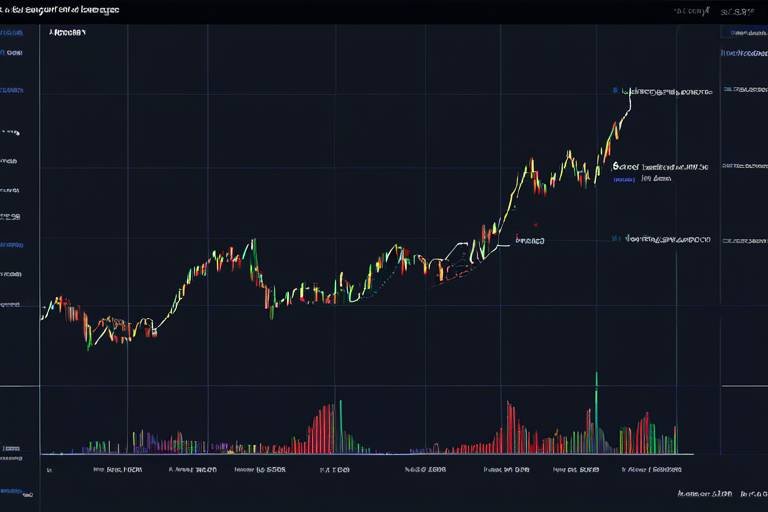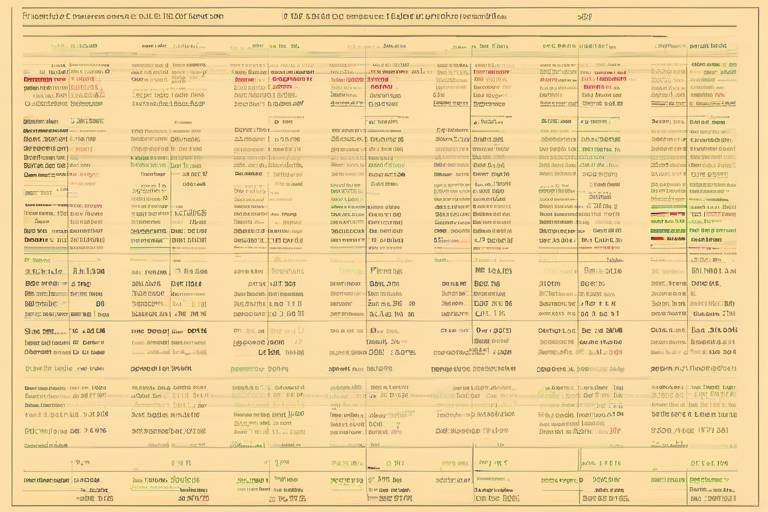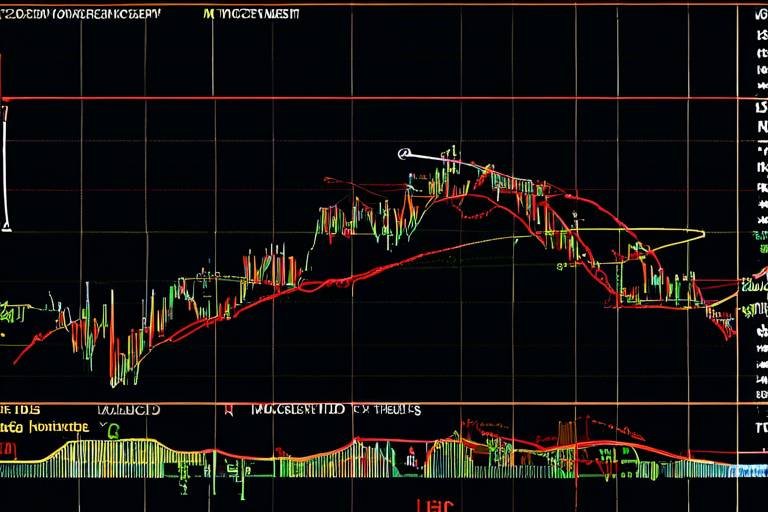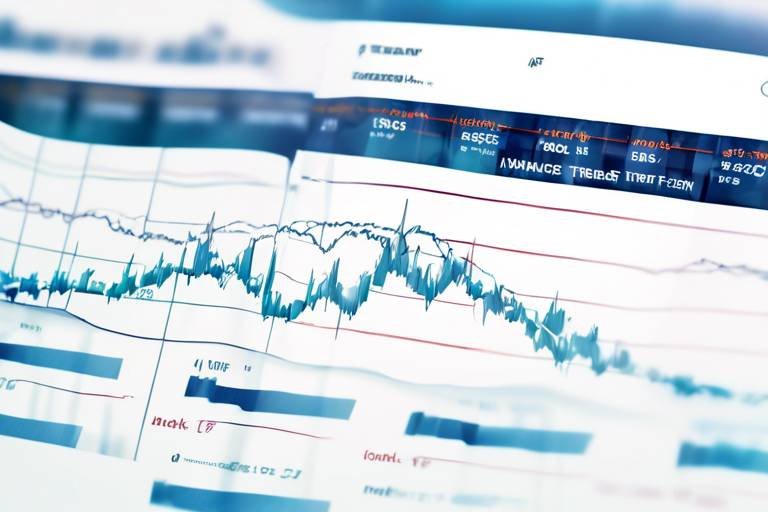How to Create a Trading Strategy Based on Technical Signals
In the ever-evolving world of trading, having a solid strategy is your best friend. Think of it as your roadmap in a dense forest; without it, you might get lost in the chaos of market fluctuations. Crafting a trading strategy that utilizes technical signals can significantly enhance your decision-making process, allowing you to navigate the markets with confidence. But what exactly are these technical signals, and how can you harness their power to improve your trading outcomes? This article will delve into the essential components of developing a trading strategy that leverages these signals, providing insights into analysis, indicators, risk management, and practical implementation for successful trading.
At its core, technical signals are indicators derived from price movements and trading volume. They serve as crucial tools for traders, enabling them to make informed decisions based on historical data rather than relying solely on gut feelings. Imagine walking into a dark room; technical signals are like the flashlight that illuminates your path, revealing potential opportunities and risks. These signals can be generated through various methods, including price charts, volume analysis, and mathematical calculations, giving traders a comprehensive view of market dynamics.
There are various types of technical indicators, each serving a unique purpose in the trading ecosystem. Understanding these indicators is akin to learning the different tools in a toolbox; each has its specific function and can be used in various scenarios. Popular indicators like moving averages, Relative Strength Index (RSI), and Moving Average Convergence Divergence (MACD) are essential for traders looking to identify trends and make calculated decisions. In the following sections, we will explore these indicators in detail, highlighting their functions and how to interpret them effectively.
Trend indicators are like the compass of your trading strategy; they help you identify the direction of the market. Knowing whether the market is trending upwards, downwards, or sideways can significantly influence your trading decisions. Some of the most commonly used trend indicators include moving averages and the Average Directional Index (ADX). These tools not only provide insights into market direction but also help traders gauge the strength of the trend, enabling them to make more informed choices.
Moving averages smooth out price data to identify trends over specific periods. They act like a filter, allowing traders to see the underlying trend without the noise of daily price fluctuations. There are two primary types of moving averages: Simple Moving Average (SMA) and Exponential Moving Average (EMA). The SMA calculates the average price over a set number of periods, while the EMA gives more weight to recent prices, making it more responsive to new information. Each has its advantages and limitations, and understanding these can help you choose the right one for your trading strategy.
The ADX measures the strength of a trend, regardless of its direction. Think of it as a gauge that tells you whether the market is trending strongly or if it's in a state of indecision. A high ADX value indicates a strong trend, while a low value suggests a weak trend. By incorporating ADX into your trading strategy, you can better assess market conditions and enhance your decision-making process.
Momentum indicators gauge the speed of price movements, helping traders spot potential reversals or continuations. These indicators are crucial for identifying when a trend might be losing steam or gaining strength. Key momentum indicators like the Relative Strength Index (RSI) and the Stochastic Oscillator provide valuable insights into overbought or oversold conditions in the market. By understanding how to apply these indicators, you can craft effective trading strategies that capitalize on market momentum.
Effective risk management is crucial for long-term trading success. It's like wearing a seatbelt in a car; it may not prevent accidents, but it certainly minimizes the impact. In trading, this means implementing techniques that protect your capital while allowing for potential gains. Essential risk management techniques include position sizing, stop-loss orders, and diversification strategies. Each of these plays a vital role in ensuring that your trading journey is as smooth as possible.
Position sizing determines the amount of capital allocated to each trade. It's essential to understand how to calculate optimal position sizes based on your risk tolerance and account size. For instance, if you have a $10,000 trading account and are willing to risk 2% on a single trade, your maximum risk would be $200. This method helps ensure that no single trade can significantly impact your overall capital, allowing you to trade with confidence.
Stop-loss orders are vital for minimizing losses and protecting your capital. They act as a safety net, automatically closing a position when it reaches a predetermined price. There are different types of stop-loss strategies, including fixed stop-losses, trailing stop-losses, and volatility-based stop-losses. Implementing these strategies effectively can safeguard you against adverse market movements and help you maintain your trading discipline.
- What are technical signals? Technical signals are indicators derived from price movements and trading volume that help traders make informed decisions.
- How do I choose the right technical indicators? The choice of indicators depends on your trading style, goals, and the market conditions you are analyzing.
- Why is risk management important? Risk management is crucial for protecting your capital and ensuring long-term trading success.

Understanding Technical Signals
In the world of trading, technical signals serve as the compass guiding traders through the turbulent waters of market fluctuations. These signals are derived from the analysis of price movements and trading volume, allowing traders to make informed decisions based on historical data. But what exactly are these signals, and why are they so significant? Think of technical signals as the heartbeat of the market; they pulse with information that traders can interpret to predict future movements.
Technical signals are generated through various methods, primarily focusing on past price actions and volume trends. When traders analyze charts, they look for patterns that can indicate potential price movements. For instance, if a stock has consistently risen during a particular pattern, traders might interpret this as a bullish signal, suggesting that the price could continue to rise. On the flip side, if the price has been declining, it may signal a bearish trend. Essentially, these signals provide a framework for traders to gauge market sentiment and make decisions accordingly.
One of the primary reasons traders rely on technical signals is their ability to eliminate emotional decision-making. In the heat of trading, emotions can cloud judgment, leading to impulsive actions that result in losses. However, by relying on technical indicators, traders can base their decisions on data rather than feelings. This objectivity is crucial for long-term success in trading. It’s like having a map when navigating through a dense forest; without it, you might wander aimlessly, but with it, you can chart a clear course.
Moreover, technical signals can be categorized into two main types: leading indicators and lagging indicators. Leading indicators, such as the Relative Strength Index (RSI), attempt to predict future price movements, giving traders a heads-up before the market reacts. On the other hand, lagging indicators, like moving averages, are based on past price data and confirm trends after they occur. Understanding the difference between these types of indicators is essential for developing a robust trading strategy.
To sum it up, technical signals are invaluable tools for traders looking to navigate the complexities of the market. They provide insights into price movements and help traders make informed decisions while minimizing emotional influences. Whether you're a seasoned trader or just starting, grasping the concept of technical signals is fundamental to your trading journey. So, are you ready to dive deeper into the world of technical indicators and enhance your trading strategy?

Types of Technical Indicators
When it comes to trading, understanding the different types of technical indicators is crucial for making informed decisions. These indicators help traders analyze price movements and trading volumes, ultimately guiding them in their trading strategies. There are several categories of technical indicators, each designed to fulfill a specific purpose. By familiarizing yourself with these indicators, you'll gain a clearer perspective on market trends and potential trading opportunities.
One of the most popular categories of technical indicators is trend indicators. These indicators are essential for identifying the direction of the market, whether it's trending upwards, downwards, or sideways. They provide traders with valuable insights into the prevailing market conditions, allowing them to align their strategies with the overall trend. Some commonly used trend indicators include:
- Moving Averages
- Average Directional Index (ADX)
Moving averages are particularly significant because they smooth out price data, making it easier to identify trends over specific periods. Traders often use both simple moving averages (SMA) and exponential moving averages (EMA). While SMAs give equal weight to all prices in the period, EMAs give more weight to recent prices, making them more responsive to new information. This responsiveness can be both an advantage and a limitation, depending on the trading strategy employed.
On the other hand, the Average Directional Index (ADX) measures the strength of a trend, regardless of its direction. It helps traders assess whether a market is trending or ranging, which is crucial for determining the right time to enter or exit a trade. A high ADX value indicates a strong trend, while a low value suggests a weak trend. By integrating ADX into your trading strategy, you can enhance your decision-making process and improve your overall trading performance.
Another important category of technical indicators is momentum indicators. These indicators gauge the speed of price movements and can help traders spot potential reversals or continuations in the market. Popular momentum indicators include the Relative Strength Index (RSI) and the Moving Average Convergence Divergence (MACD). The RSI measures the speed and change of price movements, providing insights into whether an asset is overbought or oversold. Conversely, the MACD helps traders identify potential buy and sell signals by comparing two moving averages.
To summarize, understanding the different types of technical indicators can significantly enhance your trading strategy. By incorporating trend and momentum indicators into your analysis, you can make more informed decisions and improve your chances of success in the market. Remember, the key to effective trading lies not just in knowing these indicators but also in knowing how to interpret and apply them in various market conditions.
- What are technical indicators? Technical indicators are mathematical calculations based on price and volume data that help traders analyze market trends and make trading decisions.
- How do I choose the right technical indicators for my trading strategy? The choice of indicators depends on your trading style and goals. It's essential to experiment with different indicators to find the ones that work best for you.
- Can I rely solely on technical indicators for trading? While technical indicators are valuable tools, they should not be used in isolation. It's crucial to combine them with other forms of analysis, such as fundamental analysis and market news.

Trend Indicators
Trend indicators are essential tools in a trader’s arsenal, acting like a compass that guides you through the often-turbulent waters of the financial markets. These indicators help traders identify the direction of the market—whether it’s trending upwards, downwards, or moving sideways. By understanding trends, traders can make informed decisions that align with the market's momentum, increasing their chances of success.
But how do these indicators work, and why are they so crucial? Well, think of trend indicators as the weather forecast for your trading journey. Just as a meteorologist uses various data points to predict the weather, traders use trend indicators to assess market conditions. These indicators are typically based on historical price data and can help you visualize patterns that may not be immediately apparent. Here are a few of the most commonly used trend indicators:
- Moving Averages - These are perhaps the most popular trend indicators. They smooth out price data to create a single flowing line, which makes it easier to identify the direction of the trend.
- Average Directional Index (ADX) - This indicator measures the strength of a trend, regardless of whether it’s upward or downward. It’s like checking the wind speed; you want to know how strong the trend is before you set sail.
- Parabolic SAR - This indicator provides potential entry and exit points by placing dots above or below the price chart, indicating where the price is likely to go next.
To effectively apply these indicators in your trading strategy, you must understand not just how they work, but also how to interpret their signals. For example, when using moving averages, many traders look for crossovers—when a short-term moving average crosses above a long-term moving average, it may signal a bullish trend. Conversely, a crossover in the opposite direction could indicate a bearish trend. This simple yet effective method can help traders time their entries and exits more effectively.
Moreover, it's essential to remember that no single indicator is foolproof. Each has its advantages and limitations. For instance, while moving averages are great for spotting trends, they can lag behind the market, which means you might miss out on some opportunities. On the other hand, the ADX can help you gauge the strength of a trend, but it doesn’t indicate the trend’s direction. Therefore, many traders combine multiple indicators to create a more comprehensive view of market conditions.
In summary, trend indicators are invaluable for traders looking to navigate the complexities of the market. By understanding and utilizing these tools, you can enhance your trading strategy and make more informed decisions. Remember, the key is not just to rely on one indicator but to integrate various tools to form a well-rounded approach. After all, the best traders are those who can adapt to changing market conditions, much like a skilled sailor adjusting their sails to the shifting winds.

Moving Averages
Moving averages are one of the most popular technical indicators used by traders to smooth out price data and identify trends over specific periods. Think of moving averages as a way to take the noise out of price fluctuations, allowing traders to see the underlying trend more clearly. By averaging the price over a certain number of days, traders can get a sense of whether the market is trending upwards, downwards, or moving sideways.
There are two main types of moving averages: Simple Moving Average (SMA) and Exponential Moving Average (EMA). The SMA is calculated by adding the closing prices of a security over a specified number of periods and then dividing that sum by the number of periods. On the other hand, the EMA gives more weight to the most recent prices, making it more responsive to new information. This can be particularly beneficial in fast-moving markets.
| Type of Moving Average | Calculation Method | Advantages | Limitations |
|---|---|---|---|
| Simple Moving Average (SMA) | Average of closing prices over a specified period | Smooths out price data, easy to calculate | Lagging indicator, may not react quickly to price changes |
| Exponential Moving Average (EMA) | Weighted average that gives more importance to recent prices | More responsive to price changes, better for short-term trading | Can be more volatile than SMA, may generate false signals |
When incorporating moving averages into your trading strategy, it's essential to understand how to interpret them effectively. For instance, many traders use crossovers as signals. A common strategy is to watch for the crossover of a short-term EMA over a long-term SMA, which may indicate a potential upward trend. Conversely, when the short-term EMA crosses below the long-term SMA, it could signal a downward trend.
Moreover, moving averages can also serve as dynamic support and resistance levels. When the price approaches a moving average from above, it might find support at that level, while a price approaching from below might encounter resistance. This characteristic makes moving averages a versatile tool in a trader's arsenal.
In summary, moving averages are invaluable for identifying trends and smoothing out price data, but like any tool, they should be used in conjunction with other indicators and analysis techniques. By understanding both the advantages and limitations of moving averages, traders can make more informed decisions and enhance their trading strategies.
- What is the main purpose of using moving averages in trading?
Moving averages help traders identify the direction of the trend and smooth out price fluctuations, making it easier to spot potential entry and exit points. - How do I choose the right period for a moving average?
The choice of period depends on your trading style. Shorter periods (like 10 or 20 days) are more responsive and suitable for day trading, while longer periods (like 50 or 200 days) are better for longer-term trends. - Can moving averages be used in all markets?
Yes, moving averages can be applied to various markets, including stocks, forex, and cryptocurrencies, making them a versatile tool for traders.

Average Directional Index (ADX)
The is a powerful tool in the arsenal of traders, acting as a compass that helps navigate the often tumultuous waters of financial markets. Developed by J. Welles Wilder Jr., the ADX is designed to measure the strength of a trend, irrespective of its direction. This means that whether the market is soaring to new heights or plummeting into the depths, the ADX provides valuable insights into the momentum behind these movements.
One of the key features of the ADX is its ability to filter out the noise created by price fluctuations. Instead of focusing solely on whether prices are rising or falling, the ADX quantifies the strength of that trend. A higher ADX value indicates a stronger trend, while a lower value suggests a weaker trend or a sideways market. This can be particularly useful for traders who want to avoid getting caught in choppy markets where price movements are erratic and unpredictable.
To effectively use the ADX, traders typically look for values above 20 or 25, which indicate a strong trend, and values below these thresholds, suggesting a lack of trend strength. Here’s a quick breakdown of how to interpret ADX values:
| ADX Value | Trend Strength |
|---|---|
| 0 - 20 | Weak Trend / Sideways Market |
| 20 - 25 | Emerging Trend |
| 25 - 50 | Strong Trend |
| 50 - 75 | Very Strong Trend |
| 75 - 100 | Extreme Trend |
When incorporating ADX into your trading strategy, it’s crucial to combine it with other indicators. For instance, using the ADX alongside Directional Movement Indicators (DMI) can provide a more comprehensive view of market conditions. The DMI consists of two lines: +DI and -DI, which indicate the direction of the trend. When the +DI line crosses above the -DI line while the ADX is above 20, it signals a potential buying opportunity. Conversely, if the -DI line crosses above the +DI line under similar ADX conditions, it might indicate a selling opportunity.
In summary, the ADX is an invaluable indicator for traders looking to gauge trend strength. By understanding its signals and integrating it with other tools, traders can make more informed decisions, enhancing their chances of success in the unpredictable world of trading.
- What does a high ADX value indicate? A high ADX value indicates a strong trend, regardless of whether it is upward or downward.
- Can ADX be used in any market? Yes, ADX can be applied in various markets, including forex, stocks, and commodities.
- How do I combine ADX with other indicators? Many traders use ADX in conjunction with Directional Movement Indicators (DMI) to confirm trend direction.
- Is there a perfect ADX value to trade? There is no perfect ADX value; traders typically look for values above 20 or 25 to identify strong trends.

Momentum Indicators
Momentum indicators are essential tools in a trader's toolbox, designed to measure the speed at which prices move in a particular direction. They help traders identify potential reversals or continuations in price trends. Think of momentum indicators as the pulse of the market; just as a doctor checks your heart rate to gauge your health, traders use these indicators to assess the vitality of price movements. Why is this important? Because understanding momentum can mean the difference between riding a wave of profits and getting caught in a market downturn.
One of the most popular momentum indicators is the Relative Strength Index (RSI). The RSI ranges from 0 to 100 and typically uses a threshold of 70 to indicate overbought conditions, while a reading of 30 suggests oversold conditions. When the RSI hits these extremes, it can signal a potential reversal. However, it's crucial to remember that these signals can sometimes lead to false positives, especially in strong trending markets. Therefore, traders often combine RSI with other indicators to confirm their findings.
Another key player in the momentum indicator arena is the Moving Average Convergence Divergence (MACD). The MACD consists of two moving averages and oscillates above and below a zero line. When the MACD crosses above the zero line, it can indicate bullish momentum, while a cross below may suggest bearish momentum. This indicator is particularly useful for spotting changes in trend direction and can be a powerful tool when used in conjunction with other technical analysis methods.
To better understand how momentum indicators function, let’s take a look at a simple comparison table of the RSI and MACD:
| Indicator | Purpose | Key Features |
|---|---|---|
| Relative Strength Index (RSI) | Measures the speed and change of price movements | Ranges from 0 to 100; Overbought (>70), Oversold (<30) |
| Moving Average Convergence Divergence (MACD) | Identifies trend direction and momentum | Composed of two moving averages; Crosses signal bullish/bearish trends |
When using momentum indicators, it’s essential to incorporate them into a broader trading strategy. For instance, combining the RSI with price action can enhance your decision-making process. If the RSI indicates overbought conditions, but the price continues to rise, it might suggest a strong trend that could last longer than expected. Conversely, if the RSI drops below 30, and the price is also declining, it may be a signal to consider exiting a position or tightening your stop-loss.
In conclusion, momentum indicators serve as a vital compass for traders seeking to navigate the complexities of the financial markets. By understanding the nuances of tools like the RSI and MACD, you can enhance your trading strategy and make more informed decisions. The key is to remember that no single indicator should be used in isolation; rather, they should complement each other to paint a clearer picture of market conditions.
- What are momentum indicators?
Momentum indicators are tools that measure the speed of price movements to help traders identify potential reversals or continuations in trends. - How do I use the RSI in trading?
The RSI can be used to identify overbought (>70) and oversold (<30) conditions, signaling potential reversals when these levels are reached. - What is the MACD used for?
The MACD is used to identify trend direction and momentum, with crossovers indicating potential bullish or bearish trends. - Can I rely solely on momentum indicators for trading?
While momentum indicators provide valuable insights, they should be used in conjunction with other analysis methods for better accuracy and decision-making.

Risk Management Techniques
Risk management is the backbone of any successful trading strategy. Imagine you're on a tightrope, balancing high above the ground; one wrong move and you could plunge into the depths below. That’s how trading can feel without a solid risk management plan. It’s not just about making profits; it’s about protecting your capital and ensuring you can continue to trade another day. In this section, we’ll delve into essential risk management techniques that every trader should master.
First and foremost, position sizing is crucial. This technique determines how much of your capital you allocate to a single trade. Think of it like filling a cup with water; you wouldn’t want to overflow it, right? Similarly, allocating too much capital to one trade can lead to significant losses. A common approach is to risk only a small percentage of your trading capital on each trade, often suggested to be around 1-2%. This way, even if a trade goes south, your overall capital remains relatively intact.
Next up, we have stop-loss orders. These are like safety nets that catch you before you fall too far. A stop-loss order automatically sells your security when it reaches a certain price, limiting your losses. There are various types of stop-loss strategies, such as:
- Fixed Stop-Loss: Set at a specific dollar amount or percentage below your entry price.
- Trailing Stop-Loss: Moves with the market price, locking in profits as the price rises.
- Volatility-Based Stop-Loss: Adjusts according to market volatility, providing a buffer during turbulent times.
Implementing these stop-loss strategies effectively can safeguard against unexpected market movements. For instance, if you set a trailing stop-loss, it allows you to ride the wave of a profitable trade while still having a safety net in place. This dynamic approach can help you maximize gains while minimizing potential losses.
Another fundamental aspect of risk management is diversification. Think of it as not putting all your eggs in one basket. By spreading your investments across various assets or sectors, you can reduce the impact of a poor-performing asset on your overall portfolio. For example, if one stock plummets, having a diverse portfolio means that other investments can potentially offset those losses. This strategy not only helps in risk mitigation but can also lead to more stable returns over time.
To summarize, effective risk management techniques include:
| Technique | Description |
|---|---|
| Position Sizing | Determining how much capital to allocate for each trade. |
| Stop-Loss Orders | Automated selling to limit losses at a predetermined price. |
| Diversification | Spreading investments across various assets to reduce risk. |
In conclusion, mastering these risk management techniques is vital for any trader aiming for long-term success in the markets. They serve as your protective gear, ensuring that you can navigate the often-turbulent waters of trading without capsizing. By incorporating sound risk management practices into your trading strategy, you can enhance your chances of not just surviving, but thriving in the world of trading.
1. What is the importance of risk management in trading?
Risk management is crucial because it helps protect your trading capital, minimizes losses, and ensures that you can continue trading in the long run. Without it, even a few bad trades can wipe out your entire account.
2. How do I determine my position size?
You can calculate your position size based on your total capital and the percentage of risk you're willing to take on each trade. A common method is to risk no more than 1-2% of your trading capital on a single trade.
3. Can I use multiple stop-loss strategies at once?
Yes, many traders use a combination of stop-loss strategies to tailor their risk management approach to different market conditions and trading styles.

Position Sizing
Position sizing is a critical component of any trading strategy, as it determines how much capital you allocate to each trade. Think of it as the foundation of your trading house; without a solid base, everything else can come crashing down. The right position size can help you maximize profits while minimizing risks, ensuring that you stay in the game even during turbulent market conditions. But how do you figure out what that optimal size is? Well, it all boils down to your risk tolerance, account size, and the specific trade setup.
To begin with, you need to assess your risk tolerance. This is essentially how much of your trading capital you are willing to risk on a single trade. A common rule of thumb is to risk no more than 1-2% of your total account balance on any given trade. For example, if you have a trading account of $10,000, risking 1% means you would only risk $100 on a single trade. This approach helps to ensure that even a series of losses won't wipe out your account.
Next, consider your account size. The larger your account, the more flexibility you have in terms of position sizing. However, this doesn’t mean you should become reckless. Always stick to your risk management rules. A practical way to calculate position size is by using the formula:
| Formula | Description |
|---|---|
| Position Size (Account Risk × Account Size) / Trade Risk | This formula helps you determine how many units of an asset you can buy based on your risk parameters. |
Let’s break this down further. If you’re willing to risk 1% of a $10,000 account, that’s $100. Now, if your stop-loss is set at a distance of $2 from your entry point, your trade risk per unit is $2. Plugging the numbers into the formula gives you:
Position Size ($100 × $10,000) / $2 50 units.
So, you could buy 50 units of the asset without exceeding your risk tolerance. This method not only helps you manage risk but also allows you to adapt your position size based on varying market conditions and your trading strategy.
In addition to these calculations, it's essential to remain flexible and adjust your position sizes as your account grows or shrinks. Regularly reviewing your risk tolerance and adapting to changing market conditions can make a significant difference in your trading performance. Remember, the goal is not just to make profits but to protect your capital as well.
In summary, position sizing is more than just a number; it's about creating a robust trading strategy that aligns with your financial goals and risk appetite. By mastering this aspect of trading, you can set yourself up for long-term success and navigate the markets with confidence.
- What is the best position size for trading? The best position size varies for each trader based on their risk tolerance and account size, but a common recommendation is to risk no more than 1-2% of your total account on a single trade.
- How often should I adjust my position sizes? You should regularly review and adjust your position sizes based on changes in your account balance and market conditions.
- Can position sizing help me avoid large losses? Yes, effective position sizing is a key risk management technique that helps protect your capital from significant losses.

Stop-Loss Strategies
When it comes to trading, one of the most crucial elements to consider is how to protect your capital. This is where come into play. A stop-loss order is like having a safety net; it helps you minimize losses by automatically selling your asset when it reaches a certain price. Think of it as setting up a guardrail on a winding mountain road—while you might enjoy the drive, you definitely want to avoid tumbling off the edge!
There are several types of stop-loss strategies you can implement, each tailored to different trading styles and market conditions. Let's dive into some of the most effective ones:
- Fixed Stop-Loss: This is the most straightforward approach. You simply set a predetermined price at which you will exit a trade. For example, if you buy a stock at $100, you might place a stop-loss order at $95. This way, if the stock price drops to $95, your order will trigger, limiting your loss to 5%.
- Percentage-Based Stop-Loss: Instead of a fixed dollar amount, this strategy involves setting your stop-loss at a percentage below your entry price. For instance, if you decide on a 10% stop-loss and buy a stock at $100, your stop-loss would be at $90. This method adjusts with the price movement, providing a dynamic safety net.
- Volatility Stop-Loss: This strategy takes market volatility into account. You can calculate your stop-loss based on the average true range (ATR) of the asset. For instance, if the ATR is $5, you might set your stop-loss at $5 below your entry price, allowing for normal price fluctuations while still protecting your capital.
Implementing a stop-loss strategy is not just about selecting the right type; it's also about understanding when to adjust your stop-loss orders. As your trade moves in your favor, you might want to tighten your stop-loss to lock in profits. This is often referred to as a trailing stop-loss. For example, if you set a trailing stop-loss 5% below the highest price reached after entering the trade, it will automatically adjust upward as the price increases, ensuring that you capture gains while still protecting against downturns.
Now, you might be wondering, “How do I choose the best stop-loss strategy for my trading style?” The answer lies in your risk tolerance and trading goals. If you prefer a more aggressive approach, you might opt for a tighter stop-loss to minimize potential losses quickly. On the other hand, if you’re a more conservative trader, a wider stop-loss might be more suitable, allowing for greater price fluctuations before exiting a trade.
In summary, stop-loss strategies are essential tools in a trader's arsenal. They not only help in limiting losses but also provide peace of mind, allowing you to focus on making informed trading decisions without the constant fear of unexpected market movements. Whether you choose a fixed, percentage-based, or volatility stop-loss, the key is to remain disciplined and stick to your strategy, even when emotions run high.
Q: What is a stop-loss order?
A: A stop-loss order is an instruction to sell a security when it reaches a certain price, designed to limit an investor's loss on a position.
Q: How do I determine the right stop-loss level?
A: The right stop-loss level depends on your trading strategy, risk tolerance, and market conditions. It can be a fixed amount, a percentage, or based on volatility.
Q: Can I adjust my stop-loss once it's set?
A: Yes, you can adjust your stop-loss as the trade progresses, especially if you want to lock in profits or if market conditions change.
Q: What happens if the market gaps down past my stop-loss?
A: In a gap down scenario, your stop-loss order may execute at the next available price, which could be lower than your stop-loss level. This is known as slippage.
Frequently Asked Questions
- What are technical signals in trading?
Technical signals are indicators derived from price movements and trading volume. They help traders make informed decisions by analyzing past market behavior to predict future price movements.
- How do I choose the right technical indicators for my strategy?
Choosing the right technical indicators depends on your trading style and goals. Popular indicators include moving averages, RSI, and MACD. It's essential to understand how each indicator works and how they complement each other in your strategy.
- What is the difference between simple and exponential moving averages?
Simple moving averages (SMA) calculate the average price over a specific period, giving equal weight to all prices. In contrast, exponential moving averages (EMA) give more weight to recent prices, making them more responsive to new information.
- How can I assess the strength of a trend using ADX?
The Average Directional Index (ADX) measures the strength of a trend, regardless of its direction. An ADX value above 25 typically indicates a strong trend, while a value below 20 suggests a weak trend. Traders use this information to make better trading decisions.
- What are momentum indicators, and why are they important?
Momentum indicators measure the speed of price movements and help traders identify potential reversals or continuations in the market. They are crucial for timing entries and exits in trades, enhancing overall trading strategy effectiveness.
- What is position sizing, and why is it important?
Position sizing determines how much capital to allocate to each trade based on your risk tolerance and account size. Proper position sizing is essential for managing risk and protecting your capital in the long run.
- How do stop-loss orders work?
Stop-loss orders are predefined exit points that automatically close a trade when the price reaches a certain level. They help minimize losses and protect your trading capital from adverse market movements.
- What are some effective risk management techniques?
Effective risk management techniques include position sizing, using stop-loss orders, and diversifying your portfolio. These strategies help safeguard your capital and ensure long-term trading success.



















